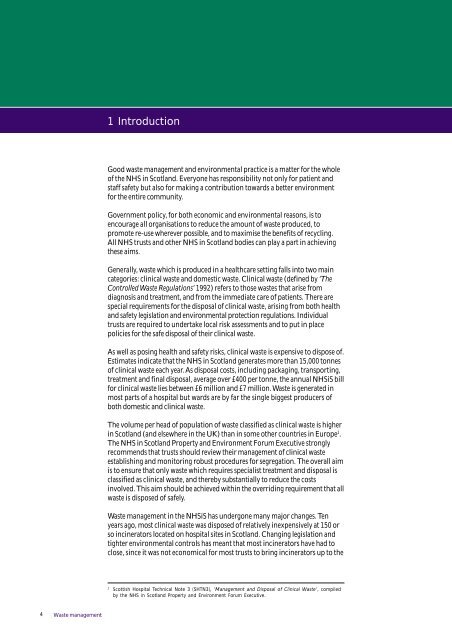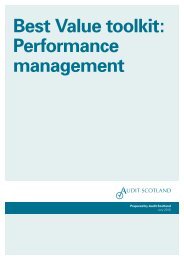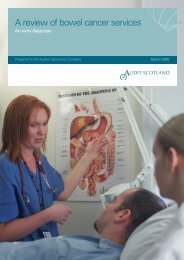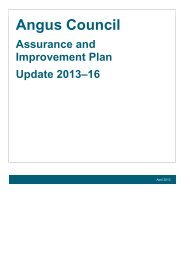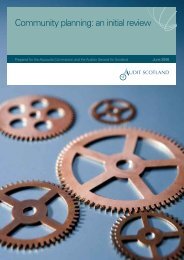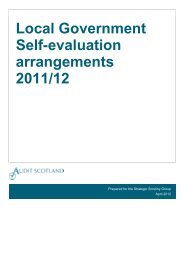Waste management in Scottish hospitals (PDF | 124 ... - Audit Scotland
Waste management in Scottish hospitals (PDF | 124 ... - Audit Scotland
Waste management in Scottish hospitals (PDF | 124 ... - Audit Scotland
Create successful ePaper yourself
Turn your PDF publications into a flip-book with our unique Google optimized e-Paper software.
1 Introduction<br />
Good waste <strong>management</strong> and environmental practice is a matter for the whole<br />
of the NHS <strong>in</strong> <strong>Scotland</strong>. Everyone has responsibility not only for patient and<br />
staff safety but also for mak<strong>in</strong>g a contribution towards a better environment<br />
for the entire community.<br />
Government policy, for both economic and environmental reasons, is to<br />
encourage all organisations to reduce the amount of waste produced, to<br />
promote re-use wherever possible, and to maximise the benefits of recycl<strong>in</strong>g.<br />
All NHS trusts and other NHS <strong>in</strong> <strong>Scotland</strong> bodies can play a part <strong>in</strong> achiev<strong>in</strong>g<br />
these aims.<br />
Generally, waste which is produced <strong>in</strong> a healthcare sett<strong>in</strong>g falls <strong>in</strong>to two ma<strong>in</strong><br />
categories: cl<strong>in</strong>ical waste and domestic waste. Cl<strong>in</strong>ical waste (def<strong>in</strong>ed by ‘The<br />
Controlled <strong>Waste</strong> Regulations’ 1992) refers to those wastes that arise from<br />
diagnosis and treatment, and from the immediate care of patients. There are<br />
special requirements for the disposal of cl<strong>in</strong>ical waste, aris<strong>in</strong>g from both health<br />
and safety legislation and environmental protection regulations. Individual<br />
trusts are required to undertake local risk assessments and to put <strong>in</strong> place<br />
policies for the safe disposal of their cl<strong>in</strong>ical waste.<br />
As well as pos<strong>in</strong>g health and safety risks, cl<strong>in</strong>ical waste is expensive to dispose of.<br />
Estimates <strong>in</strong>dicate that the NHS <strong>in</strong> <strong>Scotland</strong> generates more than 15,000 tonnes<br />
of cl<strong>in</strong>ical waste each year. As disposal costs, <strong>in</strong>clud<strong>in</strong>g packag<strong>in</strong>g, transport<strong>in</strong>g,<br />
treatment and f<strong>in</strong>al disposal, average over £400 per tonne, the annual NHSiS bill<br />
for cl<strong>in</strong>ical waste lies between £6 million and £7 million. <strong>Waste</strong> is generated <strong>in</strong><br />
most parts of a hospital but wards are by far the s<strong>in</strong>gle biggest producers of<br />
both domestic and cl<strong>in</strong>ical waste.<br />
The volume per head of population of waste classified as cl<strong>in</strong>ical waste is higher<br />
<strong>in</strong> <strong>Scotland</strong> (and elsewhere <strong>in</strong> the UK) than <strong>in</strong> some other countries <strong>in</strong> Europe 1 .<br />
The NHS <strong>in</strong> <strong>Scotland</strong> Property and Environment Forum Executive strongly<br />
recommends that trusts should review their <strong>management</strong> of cl<strong>in</strong>ical waste<br />
establish<strong>in</strong>g and monitor<strong>in</strong>g robust procedures for segregation. The overall aim<br />
is to ensure that only waste which requires specialist treatment and disposal is<br />
classified as cl<strong>in</strong>ical waste, and thereby substantially to reduce the costs<br />
<strong>in</strong>volved. This aim should be achieved with<strong>in</strong> the overrid<strong>in</strong>g requirement that all<br />
waste is disposed of safely.<br />
<strong>Waste</strong> <strong>management</strong> <strong>in</strong> the NHSiS has undergone many major changes. Ten<br />
years ago, most cl<strong>in</strong>ical waste was disposed of relatively <strong>in</strong>expensively at 150 or<br />
so <strong>in</strong>c<strong>in</strong>erators located on hospital sites <strong>in</strong> <strong>Scotland</strong>. Chang<strong>in</strong>g legislation and<br />
tighter environmental controls has meant that most <strong>in</strong>c<strong>in</strong>erators have had to<br />
close, s<strong>in</strong>ce it was not economical for most trusts to br<strong>in</strong>g <strong>in</strong>c<strong>in</strong>erators up to the<br />
1<br />
<strong>Scottish</strong> Hospital Technical Note 3 (SHTN3), ‘Management and Disposal of Cl<strong>in</strong>ical <strong>Waste</strong>’, compiled<br />
by the NHS <strong>in</strong> <strong>Scotland</strong> Property and Environment Forum Executive.<br />
4 <strong>Waste</strong> <strong>management</strong>


